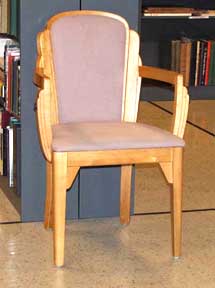Art Deco Architecture .................. Modern Funiture ................. Illustrated FURNITURE Glossary
Furnishings - Art Deco / Moderne / Streamline
1925-1940

|
Art Deco Style Proportions Small to medium. Essential elements Bold geometric shapes based on traditional forms. Simplified geometric ornament. Materials Pine or maple for less expensive lacquered or painted pieces; mahogany, walnut, or more exotic woods for finer examples. Sometimes metal or glass. Notable forms Overstuffed armchair, sofa, and ottoman. Dining-room and kitchen sets. Side, coffee, and end tables. Beds. Other distinctive forms.
|
|
|
Art Moderne / Streamline Sometimes classified as the later phase of Art Deco. Art Moderne is a horizontal design, emphasizing movement and sleekness; Art Deco emphasizes verticality and stylized, geometric ornamentation.
|
|
Art Deco vs. Art Moderne
The term Art Deco is often applied to furniture from the 1920s through the 1940s. So is the term Art Moderne. Understanding the difference between the two isn't always easy - especially since, just to add to the confusion, Art Deco was actually called Moderne in its own time, and today, much of what's technically Moderne is called Art Deco. Art Deco The style known today as Art Deco (a term actually coined in the 1960s) hit the world in 1925, at the Paris Exposition Internationale des Arts Décoratifs et Industriels, a sort of world's fair for furniture - though it had actually begun to develop several years earlier (the Exposition had been planned for 1915, but was delayed by the onset of World War I). Art Deco built on the stylized, cleanly lined forms of immediate style predecessors Art Nouveau and Jugendstil. Whole books can be (and have been) written on the various influences on Art Deco, which range from Greco-Roman to Egyptian to Asian. Just because they were simplified and stylized, however, doesn't mean that Art Deco pieces were plain or Spartan. Its practitioners were not form-follows-function guys (in fact, some of the furniture designed by architect Frank Lloyd Wright was notoriously unfunctional). Art Deco designers were all for ornamentation - just a different, more restrained kind of ornamentation. Victorians loved to stick stuff onto furniture, to embellish basic frames and shapes. With Art Deco, the texture and embellishment came from contrasts in the materials - variously colored woods and inlays - or in the material itself: burled or birds-eye or visibly grained woods, tortoise shell, ivory, tooled leathers. Lacquered glosses accentuated color differences. Animal skins and patterned fabrics in bright colors were popular, too. Like the Jazz Era in which it thrived, Art Deco furniture conveys a sense of dash and lightness. Some of that sensation derives from the lively patterns of its wood or upholstery; some derives from the contrasting shapes contained with a piece. A square table-top might sit on a lyre-shaped base, for example, or a kidney-shaped desk might stand on four ramrod-straight legs Art Moderne If Art Deco has its roots in France, Art Moderne (also known as American Moderne or Modernist) is native to the United States, dating approximately from the early 1930s and lasting until the 1940s. And it shares many of the qualities associated with the country in that period: bigger, bolder, and brassier - literally. Think of Art Moderne as Art Deco on steroids. Art Deco placed an emphasis on shape and absence of superfluity, but Moderne was positively streamlined (a hot new scientific theory of the time: the shaping of objects along curving lines to cut wind resistance and make them move more efficiently). The furniture is much more pared or stripped down, making all the more prominent its geometric outline (especially beloved: a swelling curve, like a tear drop or torpedo). Moderne designers often conceived pieces as a series of escalating levels - breakfronts were big - similar to a staircase or the setback effect of those newfangled skyscrapers that were arising in every city. Some of Moderne's most iconic pieces, designed by Paul Frankl, were actually called "Skyscraper" furniture. Though light and uncluttered, Moderne pieces never seem skimpy, thanks to the sensuality of their rounded, curvaceous forms. As in Art Deco furniture, big use is made of color contrasts, especially black and white, and contrasting materials - not just to different woods, but chrome, metal and plastics. Slick, shiny surfaces continue to predominate, giving furniture the gloss of a new machine. - Troy Segal, "Art Deco Vs. Art Moderne." AboutHome (online Feb. 2017) |
Examples from Buffalo:
- Illustration above: Chair - Old Editions Book Shop and Café
- Misc. - Kelly Schultz Antiques
- Misc. - 37 Oakland Place
- Table - Burchfield Penney Museum
- Mohair sofa and chairs, table, radio - Buffalo & Erie County Historical Society Museum
- Chest of drawers - Private collection, Buffalo, NY
- Six ceiling lighting fixtures - Carl Slone Antique Lighting and Windows
- Stations of the Cross, paintings - Buffalo Religious Art Center
- Photo: Bowl - Private collection, Hamburg, NY
- Photo: French style armoire - Emilie C. Weber House
- Photo: Dressing table - Private collection, Buffalo, NY ... Detail: Bakelite drawer pull
Other examples:
- Armchair - Aalto, Armchair (1932) . Montreal Museum of Fine Arts Streamline style
- Weber, Lounge chair - Montreal Museum of Fine Arts Streamline
- Parizeau, Dressing Table and Chair - Montreal Museum of Fine Arts
- Furniture and sculpture - Royal Ontario Museum
- Vases - Corning Museum of Glass
- Lalique, Oranges vase - Montreal Museum of Fine Arts
- Photo: Wall sconce - Grand Hotel, Amsterdam, Netherlands
- Picture frame - Memorial Art Gallery of the U. of Rochester
